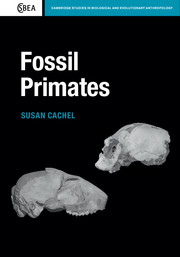Book contents
- Frontmatter
- Dedication
- Contents
- Acknowledgments
- Preface
- 1 Introduction: primates in evolutionary time
- 2 Primate taxonomy
- 3 Fossils and fossilization
- 4 The world of the past
- 5 The lifeways of extinct animals
- 6 Evolutionary processes and the pattern of primate evolution
- 7 Primate origins
- 8 The Paleocene primate radiation
- 9 The Eocene primate radiation
- 10 The Malagasy primate radiation
- 11 The Oligocene bottleneck
- 12 Rise of the anthropoids
- 13 The platyrrhine radiation
- 14 The Miocene hominoid radiation
- 15 The cercopithecoid radiation
- 16 Late Cenozoic climate changes
- 17 Conclusions
- References
- Index
8 - The Paleocene primate radiation
Published online by Cambridge University Press: 05 April 2015
- Frontmatter
- Dedication
- Contents
- Acknowledgments
- Preface
- 1 Introduction: primates in evolutionary time
- 2 Primate taxonomy
- 3 Fossils and fossilization
- 4 The world of the past
- 5 The lifeways of extinct animals
- 6 Evolutionary processes and the pattern of primate evolution
- 7 Primate origins
- 8 The Paleocene primate radiation
- 9 The Eocene primate radiation
- 10 The Malagasy primate radiation
- 11 The Oligocene bottleneck
- 12 Rise of the anthropoids
- 13 The platyrrhine radiation
- 14 The Miocene hominoid radiation
- 15 The cercopithecoid radiation
- 16 Late Cenozoic climate changes
- 17 Conclusions
- References
- Index
Summary
The plesiadapoid primates
What events took place 65.5 mya at the beginning of the Cenozoic Era, which is colloquially known as “The Age of Mammals?” This is the Cretaceous/Tertiary (K/T) boundary, and it is now clear that most placental mammal orders originate after this boundary (O’Leary et al., 2013). This realization was achieved after integrating over 4,500 morphological traits from living and fossil placentals with molecular data. If this analysis is corroborated, the typical age gap between phylogenies derived from fossils and those from DNA has been eliminated. In practical terms, what this means is that the search for unknown, ghostly Cretaceous ancestors for primates and other placentals will cease. Ideas about primate origins that are based on a Late or even Middle Cretaceous genesis are vitiated (Chapter 7). The oldest known placental genus is only 91 mya. In addition, skeletal, dental, brain, uterine, and other soft-tissue traits of the hypothetical common ancestor of all placentals can be reconstructed (O’Leary et al., 2013:Fig. 2). Most astonishing is the documentation that about 10 speciation events separating placental orders occurred in as little as 200,000 years—a fantastically high rate of morphological evolution. As a group, placental mammals clearly experienced an incandescent evolutionary radiation as they began to occupy niches left vacant by the extinction of terrestrial dinosaurs and reptiles that were specialized for life in the water and air. What place did primates hold in the great placental radiation?
- Type
- Chapter
- Information
- Fossil Primates , pp. 120 - 135Publisher: Cambridge University PressPrint publication year: 2015



